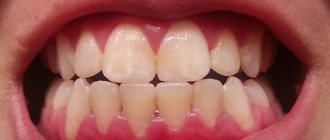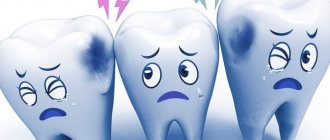It is not easy to damage enamel - it mainly occurs as a result of carious processes or mechanical stress (for example, when choosing a toothbrush with hard bristles or abusing whitening procedures at home), with a lack of vitamins or the wrong food, with immune or endocrine disorders of the body. There is also the concept of “hypoplasia” - this is a congenital anomaly in which there is the presence of very thin enamel or its complete absence.
Strengthening teeth is possible both at home and in a dental office. However, there is one condition - only a doctor should prescribe treatment. Specialists at the Smile-at-Once center conduct a thorough diagnosis of the condition of the patient’s tooth enamel, identify the causes of the problem, and then draw up a treatment plan - as a rule, it includes procedures that are carried out in the clinic, as well as measures that the patient himself must carry out during treatment. at home.
What does enamel consist of?
Tooth enamel is the hardest tissue of the human body. It is low in water (2-3%) and organic matter (1-2%). The main share (95-97%) falls on minerals - mainly calcium phosphate in the form of hydroxyapatite crystals, as well as magnesium, fluorine, carbon and some other elements.
Beneath the outer covering is a more porous layer of dentin, covering the pulp chamber, which is filled with loose connective tissue containing blood vessels and nerve fibers (pulp).
The thickness of the enamel layer can reach 2 mm in the chewing plane of the tooth and thins to 0.01 mm in the cervical zone.
Why is tooth enamel damaged?
Enamel is damaged not only by acids of bacterial origin. This is a tissue that slowly wears out physiologically throughout a person’s life.
However, for some, the thinning of the enamel occurs much faster and pathologically: this is especially true for people suffering from bruxism, that is, teeth grinding, and in patients with partial absence of teeth that impair their condition; the phenomenon of thin enamel is often observed in people who are aging due to the stress present in their daily lives; Reducing the height of the teeth and constant grinding can lead to excessive growth of the masticatory muscles and their constriction, giving the face a “square” appearance. Lack of treatment can lead to the appearance of pain symptoms associated with the temporomandibular joints, the elimination of which is already difficult; When grinding teeth, dentin is exposed, and this is not such a strong tissue, so the process of thinning the enamel is accelerated. Its consequence can be inflammation of the pulp, which is eliminated by root canal treatment.
The most common disease affecting enamel is its demineralization. This is the beginning of the caries process. When bacterial fermentation of sugars occurs, various organic acids are formed and the pH in the mouth drops. This dissolves the minerals and the enamel surface. You may see it on your teeth as a dark stain.
This process affects the hard tissues of the tooth due to the dissolution of enamel by acids from food, the environment or the body. This process is observed in people who consume large amounts of fruit juices and sweet drinks.
People who work in industry (due to acids in the work environment) and people who swim in swimming pools (due to chlorine added to the water) are also at risk.
Tooth decay also occurs in people with repeated vomiting and gastrointestinal reflux (due to stomach acids affecting the teeth).
When is it time to strengthen
It is necessary to carefully monitor the condition of your teeth. If you experience frequent inflammation of the mucous membranes of the oral cavity, think about how to strengthen your gums. Otherwise, there is a risk of developing cervical caries, since the thickness of the enamel at the point of contact between the gum and the crown is minimal.
It’s time to strengthen teeth enamel if one or more signs appear.
- The color has changed. As the outer covering wears away, the yellowish layer of dentin begins to show through.
- The shape has changed. Wear and tear can cause teeth to become flatter, shorter, and rounder, making it more difficult to bite and chew food.
- A white chalky spot has appeared - the initial stage of caries, at which it is easiest to deal with it. The destruction of the layer is just beginning, so its surface remains even and smooth.
- Increased sensitivity (hyperesthesia) has appeared - a painful reaction when brushing with a toothbrush, eating sour, sweet, cold or hot foods.
- The teeth began to crumble.
Why is enamel destroyed?
Despite the high strength of enamel, there are factors that lead to its disruption or change in structure. These include:
- mechanical damage in the form of the habit of opening bottle caps with teeth, breaking threads, biting nail plates;
- improper or insufficient oral hygiene, active use of whitening pastes with abrasive particles that contribute to abrasion of the enamel layer;
- poor diet, excessive consumption of sugar-containing and highly acidic foods, such as citrus fruits;
- frequent temperature changes while consuming cold and hot foods and drinks;
- the presence of bad habits such as smoking, frequent consumption of alcohol;
- old age, because over time, useful minerals leave our body, and if new ones do not arrive, then thinning and destruction of the enamel occurs.
How to strengthen tooth enamel
At the first sign of decay, visit the dental clinic. The doctor will conduct an examination and determine the reason why your teeth are crumbling. He will advise you on how to treat tooth sensitivity.
In dental practice, there are several methods aimed at strengthening enamel and protecting against demineralization.
The most common is fluoridation. The effectiveness of this procedure has been confirmed by practice. It involves applying a special fluoride-containing composition to the surface of the teeth. Fluoride penetrates deep into the enamel and promotes better absorption of phosphorus and calcium.
As a result of fluoridation:
- the permeability of the top layer decreases;
- the smallest cracks are sealed;
- the structure of the outer shell becomes smooth and uniform;
- a natural healthy shine appears;
- resistance to pathogenic microflora and acidic environment increases;
- caries is eliminated at the stain stage;
- tooth sensitivity decreases.
Cosmetic defects in the outer covering can be hidden by installing veneers and lumineers or polishing teeth.
Strengthening tooth enamel at home
It is possible to strengthen the enamel through the process of remineralization. Currently, there are many products on the market that are popularly called liquid enamel or artificial enamel. Thanks to them, a strengthening procedure is possible. Treatment should be performed before irreversible tissue loss occurs in the tooth.
The most popular pastes for strengthening enamel are fluoride-based preparations. Fluoride ions replace dissolved hydroxide ions in the enamel and form fluorapatite, which is more resistant to caries. In addition, fluoride inhibits bacterial activity. Strengthening of enamel also occurs as a result of the use of drugs with a complex of casein phosphopeptide and amorphous calcium phosphate.
Enamel remineralizing toothpaste is an ideal complement to standard fluoride toothpaste. As preparations that restore mineral balance in the oral cavity, they are well suited for people with caries problems and are recommended after professional teeth cleaning and tartar removal. Thanks to their pleasant scents, they are easy to use even for children. Once again, it is worth saying that there is no toothpaste that restores enamel defects.
Regular preventative visits with professional remineralization are the best way to strengthen tooth enamel.
Prevention of tooth enamel destruction
Simple recommendations will help slow down the destruction of the enamel layer and keep teeth healthy.
- Visit your dentist at least once a year. Even in the absence of discomfort in the oral cavity, the doctor will see the initial stages of the disease and begin timely treatment.
- Brush your teeth at least twice a day, morning and evening, and use dental floss to remove food debris from your mouth.
- After eating, rinse your mouth with clean water and take your medication with plenty of water.
- Eat foods containing sugar less often. Each consumption of sugar leads to the growth of bacteria in the mouth.
- Limit your consumption of sugary sodas and juices - some of the acids in them are more corrosive than battery acid.
Do not forget that oral care should be carried out regularly and comprehensively throughout your life. Following one rule will only slightly reduce the risk of developing pathology. Oral care should become a habit and become a lifestyle.
How to understand that the enamel needs strengthening?
It's simple: at the initial stage of thinning of the enamel, characteristic white spots appear on the tissues. In addition, thinned enamel leads to increased tooth sensitivity.
As soon as you notice unpleasant symptoms of thinning enamel, you need to start strengthening it.
Methods for strengthening enamel at home
At the initial stage of enamel destruction, fabrics can be strengthened at home. The most effective folk remedies are:
- Activated carbon.
An excellent means of strengthening enamel is activated carbon, crushed in water to a pasty state. The resulting composition can be used to brush your teeth instead of toothpaste from time to time. - Strawberry.
From this red berry you can prepare a healing mask to strengthen the enamel. To prepare it, simply mash the strawberries into a paste and apply it to your teeth. - Green tea.
Surprisingly, this fresh, delicious drink is rich in fluoride and polyphenols, which fight oral bacteria that cause tooth decay and other diseases. According to scientific research, people who drink a glass of green tea a day are 19% less likely to lose teeth. - Rough food.
Hard carrots, apples and other raw vegetables and fruits will not only nourish the body with vitamins, but will also help clean the surface of the teeth, thereby protecting them from plaque and exposure to microbes. - Rubbing with lemon zest.
To strengthen the enamel, you need to take the white pulp of a lemon and wipe your teeth with the peel for 7 days. Long-term use of the zest is not recommended. - Baking soda
is excellent at strengthening enamel. The main thing is not to use this product more than once a week. - A mixture of garlic and beets
perfectly restores enamel. To strengthen the tissues, you must periodically apply this composition to the gums, and then rinse your mouth with soda. - Wheatgrass
is an excellent tonic. Simply chewing the stem of this plant can cleanse the enamel and relieve gum inflammation.
Effective means for strengthening enamel are mint, fennel, cinnamon, and cloves. Powders of these herbs can be used to brush your teeth. The products will not only strengthen the enamel, but also restore the tissue from darkened stains.
Dentists call ACEPTA PLUS toothpaste one of the most effective means for strengthening tooth enamel. Remineralization. The active components of this product are hydroxyapatite, a source of natural calcium and phosphorus, the enzyme papain, which quickly breaks down plaque, thermal mud, which heals and soothes the gums, as well as potassium, zinc, calendula and eleuthero extracts.
How to rinse teeth to strengthen enamel?
Effective means for strengthening enamel are rinses. Here are the most effective formulation recipes:
- Tea tree oil rinse.
To prepare the composition, you need to mix 2 drops of oil with a glass of water and use this composition to rinse the mouth. Healing oil not only destroys harmful bacteria and unpleasant odors, but also perfectly strengthens the enamel. - Rinsing with herbal
decoctions perfectly strengthens tooth enamel. To prepare such a composition, you should mix oak bark, calendula, mint, burdock, chamomile, snake knotweed, and sage in equal proportions, and then pour boiling water over the composition. The mouth should be rinsed an hour after eating. - Sea salt
not only strengthens teeth, but also eliminates increased sensitivity of tooth enamel. To prepare the rinse, dissolve 4 teaspoons of salt in half a glass of water. - Rinsing the mouth with mustard
to strengthen enamel is actively used in India. Mustard powder can also be used to clean your teeth.
So, now you know the basic ways and means of strengthening tooth enamel. Take care of yourself, visit the dentist twice a year, give up bad habits, and your teeth will “serve you faithfully” for the rest of your life.
Methods for restoring tooth enamel
Depending on the nature of the damage, the following methods are used to restore enamel.
- Fluoridation.
The surface is treated with a professional varnish with a high fluorine content to seal cracks and scratches. - Enamel implantation.
In order to mask irregularities and improve color, the tooth is coated in layers with a synthetic composition similar to natural dental tissue. - Filling.
The technology is used in cases of chips and fractures. Using photopolymer composites, the doctor builds the tooth to the desired size. - Veneering.
Ceramic onlays are fixed on the outside of the teeth to correct aesthetic defects.
All of the listed procedures for restoring tooth enamel in Moscow are carried out in almost every clinic. The most affordable is fluoridation - from 60 rubles per tooth. The installation of veneers is considered the most expensive - from 10,000 rubles for one microprosthesis.
Composition of medicated toothpastes
Dental clinics and pharmacies have a large selection of toothpastes that strengthen and restore tooth enamel. What unites and distinguishes them from each other is the composition of microelements, each of which carries its own therapeutic load. Here are some of them:
Papain
– plant enzyme. Valued for its ability to neutralize proteins and acids and dissolve plaque.
Lactate and hydroxyapatite
– active trace elements of calcium. Capable of creating microcrystals and filling cracks in enamel with them.
Polydon
– knows how to break down plaque on the surface of teeth.
Stevia
– strengthens gums, whitens teeth and protects enamel from food irritants.
Nanohydroxyapatite
- a product of calcium compounds. Quickly restores enamel. Protects damaged areas of the tooth surface.
Zinc and thymol
eliminate bad breath and actively fight harmful bacteria and microorganisms.
What is the cost of restoring tooth enamel?
The cost of restoring tooth enamel using home methods is low; healthy products, ordinary hygiene products, infusions and herbs can be purchased at any pharmacies and stores without compromising your budget. For specialized pastes and gels you will have to pay a little more - from 400 rubles per tube.
Professional methods mask aesthetic defects and prevent further tooth decay. Homemade - help strengthen the enamel layer. However, it will not be possible to completely restore the health of damaged enamel. Simple rules will help maintain its integrity - preventive examinations at the dentist, proper nutrition and giving up bad habits.
Causes of tooth enamel destruction
Why does tooth enamel, so hard and durable, erode? There are many reasons:
- love of soda, especially sweet carbonated drinks, energy drinks;
- eating large amounts of fruits and fruit juices - despite the benefits of these products, they contain acid, which is very aggressive and leads to the destruction of enamel;
- the predominance of carbohydrates in the diet (sweets, baked goods, starch-containing products);
- disruption of the salivary glands (dry mouth);
- GERD (gastroesophageal reflux disease);
- disturbances in the functioning of the digestive system;
- genetic predisposition;
- disturbance of metabolic processes in the body associated with disruption of the endocrine system;
- smoking;
- natural mechanical wear (chewing loads, friction);
- stress;
- malocclusion;
- lack of essential minerals and vitamins in the diet (and in the body);
- taking certain medications (aspirin, allergy medications, etc.);
- home whitening without supervision and consultation with a dentist, using low-quality preparations;
- using teeth for purposes other than their intended purpose (for cracking nuts and opening bottle caps);
- injuries resulting from impact, road accident;
- eating very cold and very hot foods or a combination of contrasting temperatures (hot tea after ice cream).
Another factor dangerous to enamel is the formation of plaque. In itself, it is not dangerous, but when a sticky film appears on the teeth, it becomes an ideal environment for bacteria to live and multiply. Bacterial waste products contain acids, which cause damage to the integrity of the enamel and the development of caries.










